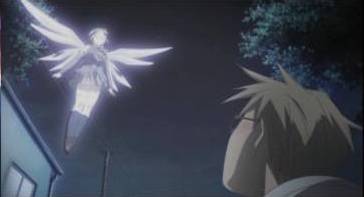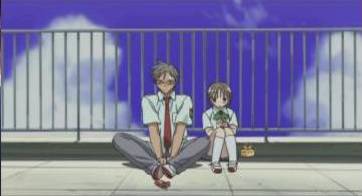|
Recently
we've seen many animé focused on a theme of innocent-looking
young girls who are also (somehow) vicious killing machines. Gunslinger
Girl, Burst
Angel, Battle
Vixens and Tenjho Tenge all follow this same
theme. On a conceptual level, She, The Ultimate Weapon
(released 15th May by Manga Entertainment) most closely
resembles Gunslinger Girl. On the one hand, you've
got a sweet, romantic story about a shy girl falling in
love with a hesitant young man. On the other, you have the
realisation that this shy, petite girl can be ordered to
destroy whole cities, and will do so without hesitation
and with startling complacency. Our main female protagonist
– and titular Ultimate Weapon – Chise believes that she's
being punished for some unknown wrongdoing, and accepts
that she is an Ultimate Weapon. It's left to her
boyfriend Shuji – as the only one who knows her secret –
to offer love and support to her, as with each action she
takes, she becomes more machine and less human.

The
backdrop to She is one of unease. It is set in the
near future, in a world where both the internet and cellphones
have been banned, and the threat of war from an unrevealed
enemy looms over Japan. Nonetheless, the lives of the people
go on as normal, with just the occasional rumbling of an
F16 fighter jet overhead. In the midst of all this are Shuji
and Chise, high-school students who've decided to fall in
love with each other. Shuji is calm and often seems aloof,
but isn't beyond emotional outbursts; Chise is very shy,
apologises a lot, and is rather slow and clumsy. She asks
Shuji to be her boyfriend, but it's more of a test to see
whether she can do it than anything she's thought over.
When
a surprise air-raid strikes their home, killing thousands,
Shuji is shocked to find Chise in the midst of the warzone,
with angelic wings and futuristic weaponry grafted to her
body. Again, this evokes themes common to Gunslinger
Girl; how could anyone do this to such a young and innocent
girl, against her will? Shuji is understandably concerned
– will their relationship survive Chise regularly being
called out to war? And just how much of her humanity is
Chise prepared to lose?
All
these questions, and so few of their answers, are posed
in Volume 1 of this thirteen-episode animé series
(based on a manga by Shin Takahashi). Four episodes are
contained in this volume; in them, we see Shuji and Chise's
relationship begin, witness Chise's gradual transformation
into a weapon of war, and along the way see how Shuji's
past girlfriend Fuyumi causes him to have second thoughts
– he asks himself whether he'd prefer a simple, easy-going
relationship with a "normal" girl, and begins to wonder
whether he's really in love with Chise. Finally, Chise realises
that she can control her new "powers", and decides that
she'll protect everyone in the world from harm – but soon
discovers that it's never that simple.
She never forgets its perspective – it's a love story, pure
and simple. No details of Chise's modifications are given
to the viewer – Chise explains "A lot of important-looking
people explained it to me, but they used such big words!".
The viewer doesn't need to be told the technical
details of what's been done to her, as that's not the focus
of the series. It purposefully avoids showing overblown
action scenes of Chise attacking the enemy, content to have
her allies congratulate her after the fact. Instead, what
we see are the harsh realities of Chise's condition, both
from her perspective and from Shuji's, and how it turns
a budding, tender relationship into an unpredictable situation.
The
animation of She is a continual delight. The "clean"-looking
school and suburban city backdrops look ok, but what really
shine through are the grasslands and forest greeneries,
faded ever-so-slightly against the lighting. Character designs
are done in a traditional animé style, with a distinctive
ruddiness around the cheeks. One comment I can raise against
the character designs of Shuji and Chise in particular is
that Shuji looks far too old – his build and hair colour
make him tower over the tiny form of Chise, and this has
a knock-on effect of making her seem far younger – to the
point where they appear (at first glance) to be brother
and sister instead of girlfriend and boyfriend.

Incidental
music is almost entirely absent in these first few episodes.
Both main characters will occasionally hum a love theme,
which I think is based on one of the two image songs, and
a powerful electric guitar riff kicks in whenever Chise
has to use her powers. Voice acting is well-performed, if
a little hesitant in some places where the sentence structure
perhaps needn't have been quite so disjointed.
She
is a story that (by the nature of its plot) will most likely
end in tragedy, and yet it's enjoyable to see the characters
try to make the best of such a tragic situation. Although
I've said that the details of Chise's modifications aren't
necessary for the viewer to know, I'd like to see how the
scientists who've done this to her think about what they've
done. Even though the focus is the love story between Chise
and Shuji, ignoring the equally-important background players
would be a mistake. Roll on Volume 2.
The
16:9 transfer here is decent enough, but disappoints by
being non-anamorphic. Colours are well reproduced, but the
contrast lacks punch, although this could be deliberate
to the look of the show.
The
soundtrack is offred in 2.0 stereo and 5.1 surround, both
Japanese and an Eglish dub. The 5.1 has better clarity and
does spread the sound around, though somewhat arbitrarily,
with sound effects emerging from the rear speakers for no
good reason. As so often with Manga animé, disc 2
contains the same material but with a DTS track, which is
basically the same as the 5.1, but louder.
She's
extra features – all on disc 2, with the DTS audio track
– kick off with Conversations with Voice Actors
(13:19), an interview with Fumiko Orikasa (Chise) and Shiro
Ishimoda (Shuji). There's a featurette, "All About
Saikano" (24:05), which is a basic "behind-the-scenes"
documentary going into more detail about the series' manga
roots. You can access a collection of short TV commercials for the series (3:08), see a feature from a Japanese animé/manga
news program, ("Saikano Times"), commenting
on it (20:07), and finally flip through character
sheets.
|